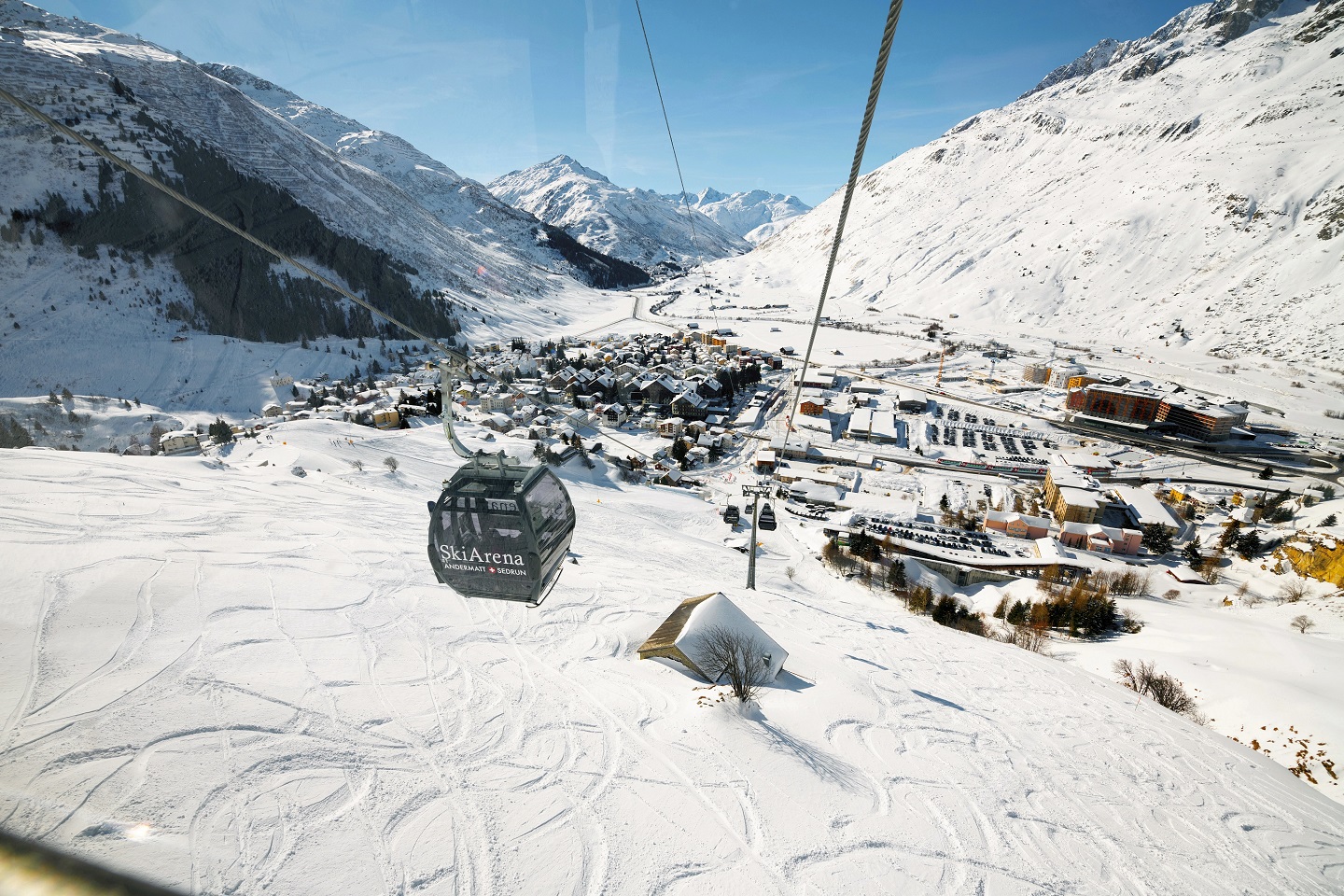
The view of Andermatt from a gondola (Photo: Valentin Luthiger)
While the two countries could not be more different at first glance, Switzerland and Malaysia surprisingly have something in common. Stay with me.
A small landlocked nation with the most breathtaking views of nature, from snow-capped mountains to verdant valleys and alpine lakes, Switzerland has evolved by adopting the customs and traditions of its neighbours. So much so that most Swiss speak two to three of the official languages (French, German, Italian and Romansh) as well as English. This exchange makes it a melting pot of cultures, so you get a mix of enriching cuisines as well as traditional holidays and practices. Sounds familiar?
One such canton in Switzerland with prominent intermingling of language and culture is Uri, or more specifically Andermatt. Options was invited to visit this growing town to explore its sprawling landscape and the upcoming properties being developed. While it is in a lesser known region, Andermatt is surprisingly accessible. By car, it can be reached via one winding pass road and by train, from all directions. Only 90 minutes from Zurich — Zurich, Basel and Milan airports are just two hours away — this mountain village is less than 10 minutes from the north-south motorway exit. On our drive, green hills make way for white mountains, with picturesque pines and rocky ravines. Our stay is at the Radisson Blu Hotel, one of Andermatt’s many hotels.
To fully understand a place, one must delve at least a little into its history. Trudging through fresh snow, surrounded by unbelievable mountain ranges, we walk through the older side of Andermatt filled with quaint buildings that have a layer of white on their roofs. It feels like strolling through a winter rom-com, or a cheesy Christmas special on Netflix. We have a local guide, who apart from being a sort-of historian for the town is also a former athlete, snowboarding teacher, co-founder of the Swiss Snowboard Association, owner of the cosy café Kiosk 61 and a crystal digger, plus a background in chemical engineering. Bänz Simmen is definitely a jack of all trades, whose interest in his town’s history began after a cycling trip from Andermatt in June 1990 ended in New Zealand a year later. All the history he learnt prompted him to go home to find out more about his own locale.
andermatt_ursern_valley_winter_2020_valentin_luthiger_04.jpg
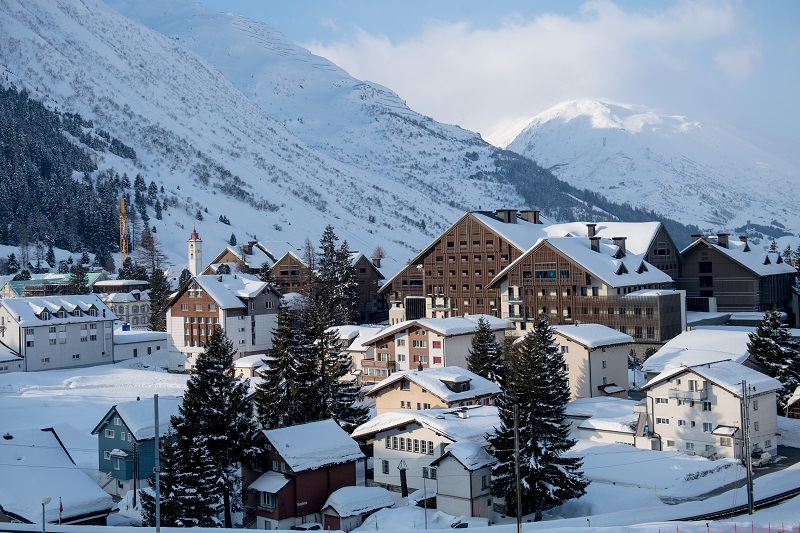
“This valley has changed so many times. And that is very much in our DNA, all over Switzerland. Can you imagine living here 400 years ago without electricity? This was such a hard life. On the other hand, you have to ask, why didn’t we leave? They must have reached the quality to say no, this is my home, my country, that’s my place. This is not really documented. So, with the history, you have to learn to read between the lines,” says Simmen.
Around 50,000 years ago, what the country is today was basically a glacier. “Switzerland has a lot of lakes. We are the lake-richest place on the continent. We have much more water than in Germany, Austria or Italy. We have no sea but a lot of freshwater. And this is one of the relics of the Ice Age,” he explains.
Located in the Ursern Valley — a name given by the Romans that roughly translates to the valley of bears — Andermatt likely had its first settlers in the year 1000, but definitely inhabited by at least the 13th century. The area had many years of semi-nomadic tribes travelling in and out, but only the mountain people, or as Simmen calls them “the first pioneers of the Alps”, understood the nature of the area and the best place to settle, away from avalanches and other dangers.
Taking refuge from the cold, we make a stop at his internet café/bar. The store is very much like its owner, filled with an eclectic mix of items from quartz crystals — which we learn was a unique commodity during the stone age — to cigarettes and touristy souvenirs to a collection of old photographs, books and skis. He pulls out a 3D map to show us how unique a position Andermatt is in. It is basically the only cross in the whole Alps, between north, south, east and west. This made the town one of the main trading hubs, important not only for goods but also information. “You knew exactly what happened in France, in Austria, in Italy and in Germany. And knowledge was important because medieval Europe was basically a time of war.
apres_ski_zug_2017_asa_01.jpg
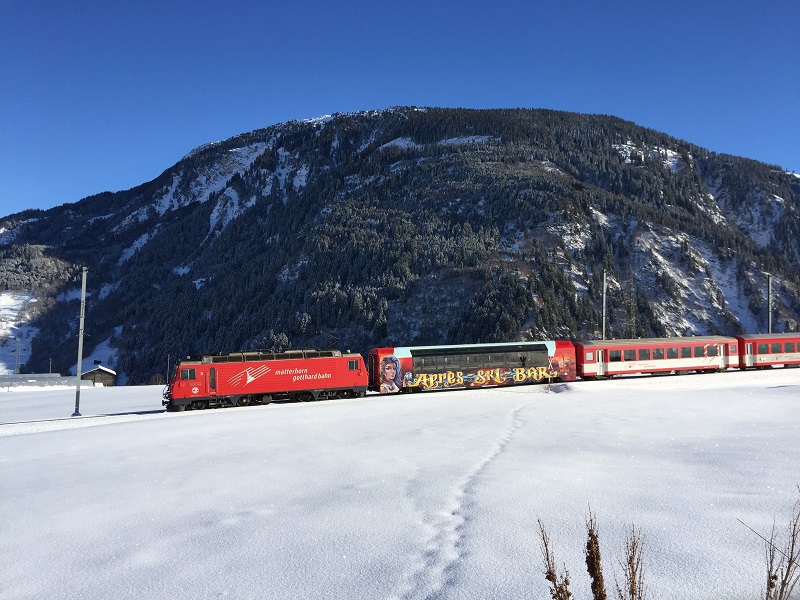
“Everybody wanted to have a relationship with Switzerland because if you wished to trade with Italy, you had to go to Switzerland. If you had a war in Italy, you had to bring your troops through Switzerland. The same goes for east to west, north to south. So, we had a lot of relations and connections to Europe, but we never had one government until 1848. For Andermatt, this was a clear trading connection, interaction with other cultures. And of course, the extension of the Silk Road.”
In 1882, the Gotthard railroad tunnel opened, enabling travellers to cut their travel time. But it meant that Andermatt was no longer a transit point. In 1885, the Swiss Army moved into the town and it was considered one of the country’s most important military bases, and from then, the infrastructure of the town, including shops and restaurants, relied solely on the thousands of people who came for training or military service. In the 1990s, when the Cold War was over, there was no need for such a large army, so Andermatt lost 20% of its already-small population.
Our walking tour comes to an end as we reach Hotel Sonne, which has been around for many years, for dinner. It has a warm rustic vibe. The highlight on the menu is the cheese fondue, a must-have experience while in Switzerland. Fondue-eating etiquette is quite interesting. Your dipped bread must be swirled in the cheese in a figure-eight pattern, and someone should always be dunking their bread in the cheese. A little pepper on the side of your plate can add spice to the rich and creamy fondue.
Our waiter gives us a shot of Kirsch, a colourless cherry aperitif, in which to dunk a corner of the bread before dousing it in cheese and eating. The pop of alcohol certainly warms up the body and gives a kick to the flavour. Traditionally, locals have a cup of black tea while having fondue, which helps temper its overwhelming richness. Finally, when the meal comes to an end, the waiter scrapes the browned crust at the bottom of the pot, which is affectionately called the grandmother. Some say consuming this slightly burnt cheesy bit is the best part, and we certainly agree.
andermatt_golf_the_swiss_house_2018_valentin_luthiger.jpg
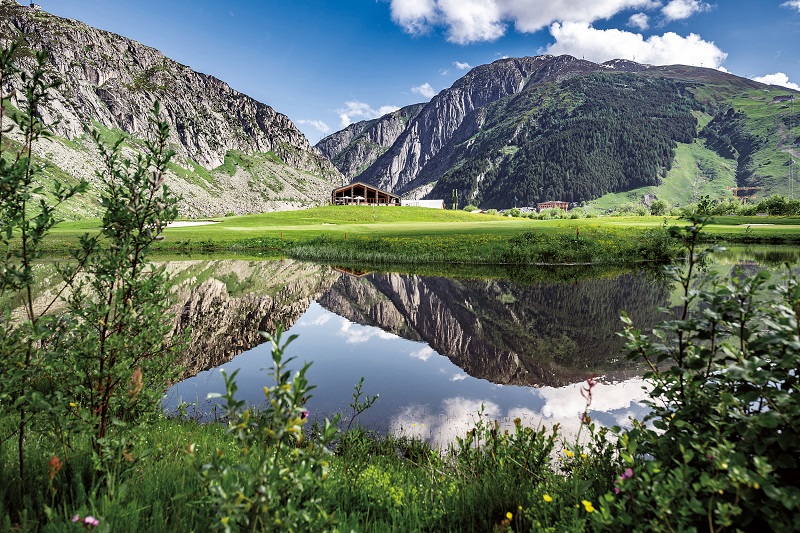
A new life
The rejuvenation of Andermatt took place because of Egyptian investor Samih Sawiris, who envisioned a tourist destination that preserved the nature of the valley. By the end of 2021, more than CHF1.3 billion had been invested in the area, to build much of the infrastructure in Andermatt Reuss. This includes chic apartment buildings and villas.
The plan for Andermatt Swiss Alps development includes 42 apartment blocks and five hotels. While 19 blocks and two hotels have been built so far, the developer intends to finish 29 houses by end 2024. Many international buyers, including Asians, have flocked to this town to buy a holiday home or move in permanently. On our visit, it is clear to see why. The quaint town is breathtaking, being surrounded by remarkable mountains, and for the outdoorsy and adventurous, there is plenty to occupy your time. The accessibility of Andermatt’s location is the cherry on top.
What is special about investing in an apartment in Andermatt is the uniqueness of the buildings. Each apartment block is designed by a different architect and has distinctive qualities. We get a chance to sit in on a presentation by Atelier Oi, an internationally renowned architect and design firm, which will be behind one of the future buildings in the area. “We don’t design a project but a moment,” we are told, and its vision for the building brings together cool stones and light-coloured wood for a chic yet warm concept.
Andermatt Swiss Alps property is also attractive to foreign buyers because it is exempt from the Lex Koller law, which restricts the acquisition of real estate by non-Swiss. Also, none of the homes in the area is affected by the Swiss Second Home Law, which regulates the construction of second homes in an area to just 20%. This is because the initiative got its approval well before the law was implemented.
snowshoe_andermatt_2022_valentin_luthiger_126_1.jpg
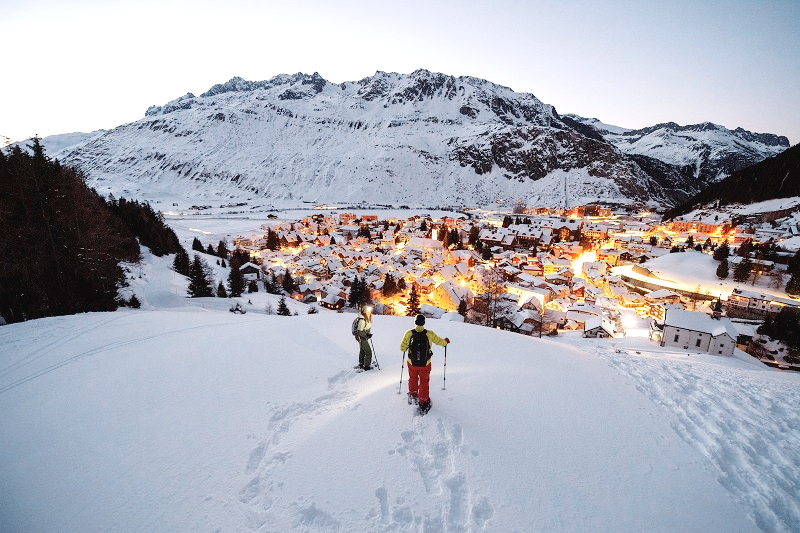
Hitting the slopes
As Andermatt is 1,400m above sea level, it is an ideal skiing destination, with December to April being the prime months. Those of us unused to the sub-zero temperatures were in awe of the 15in of snow that coated the sidewalks. But the locals laugh and say, “No, it is not a lot of snow.” At this time of year, the town is used to metre-high mounds of snow — often two metres in April — and is accustomed to the -17°C that had our teeth chattering.
Sports enthusiasts will want for nothing as there is an impressive list of activities, from skiing and freeriding to snowboarding and snow trekking. For many Swiss, skiing is a holiday pastime that goes back to their childhoods. So much so that there is even a ski week in schools, when students hit the slopes.
After having our feet scanned for the perfect boot size and getting equipped with the right jacket, pants, gloves and skis, we jump on a gondola and head for Nätschen (1,842m above sea level). Grateful to be on the same slopes as newbie children, we attempt to navigate our skis and keep our balance while clumsily gliding. Thankfully our instructor Peter Haab, also an Andermatt local and fellow journalist, went easy on us. It was very hard not to get distracted by the panoramic views and the bright sun in the clean blue sky.
Fret not if you are a more experienced skier. The Andermatt-Sedrun-Disentis range is central Switzerland’s largest ski area. This includes the formidable Gemsstock (almost 3,000m above sea level), which is only for well-versed sportsmen as it has long steep pistes and a number of deep-powder trails. Freeriders adore this terrain, but are only allowed when there is enough snow for safety reasons.
Despite the -16°C weather, we work up a sweat during our attempts to ski. We then hobble over to Alp Hittä Restaurant — one of the many eateries in the area run by the Mountain Food brand, which champions local produce — and sample pizzas as well as Swiss Alpine herder’s cheesy macaroni served with homemade apple sauce (a local favourite).
the_chedi_andermatt.jpg
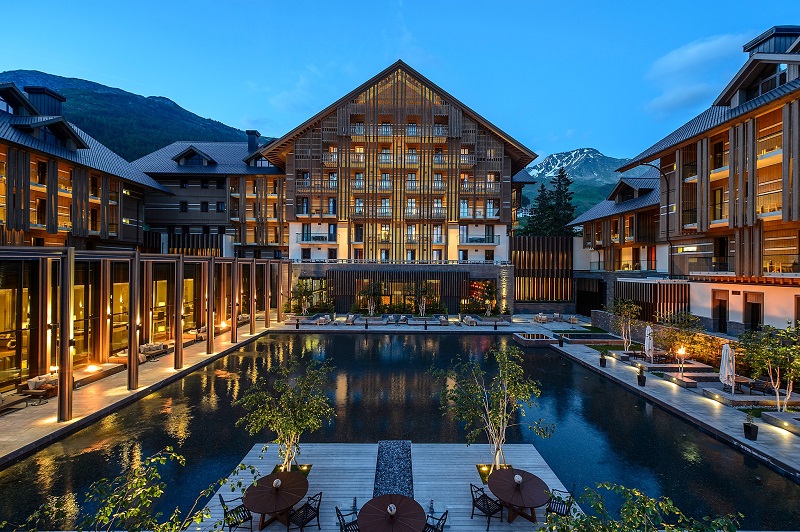
It is then time to check out the famed drinks train. Running twice a day, this is Switzerland’s longest aprés-ski train ride, which goes from Andermatt to Disentis and back, making six stops. With space to stand or comfy bar seating, this train is the perfect spot to wind down after your ski with a drink in hand. We opt for Aperol Spritz as we watch the sprawling valley transform from mountains and a frozen lake to snow-capped houses and shops.
Another highlight of the trip was the tour of The Chedi Andermatt, a five-star luxury hotel that opened in 2013 and boasts 123 rooms and suites. A symbiosis of Asian elegance and Swiss tradition, this warm space has garnered many records. The Library, so-called less because of books (but extensive nonetheless), is the area that holds the largest range of cigars worldwide with more than 900 varieties. It also has the bulk of the hotel’s 5,700 strong selection of wine bottles. Even the indoor pool is the longest in a hotel in Switzerland, at 35m.
For the first time this winter, The Chedi Andermatt’s courtyard has been transformed into the Winter Village, which includes a restaurant that serves fondue and raclette, a market booth that offers mulled wine and crepes on the weekend, as well as a private dining area and private hot tub and sauna. We get to dine at The Restaurant, which boasts four kitchens — Asian, Western, cold dishes and desserts — and recommend the Swiss Entrecôte with Jerusalem artichoke, watercress, green pepper, carrot and sweet potato gnocchi.
The best part of the meal was the trip to the cheese room, which houses more than 50 varieties from all over Europe. Guests may go in and learn about the different cheeses before choosing their preferences for dessert. Highlights for us include the appenzeller d’alpage extra, a product of the valley that has a surprisingly subtle flavour despite being aged for 19 months, and the belper knolle alt, which is like a Swiss parmesan.
Andermatt is certainly a surprise, from its interesting history to the friendly and jovial nature of the locals. It is not difficult to imagine living in such an idyllic setting, especially with the promise of new shops and stores on the way.
This article first appeared on Jan 30, 2023 in The Edge Malaysia.


